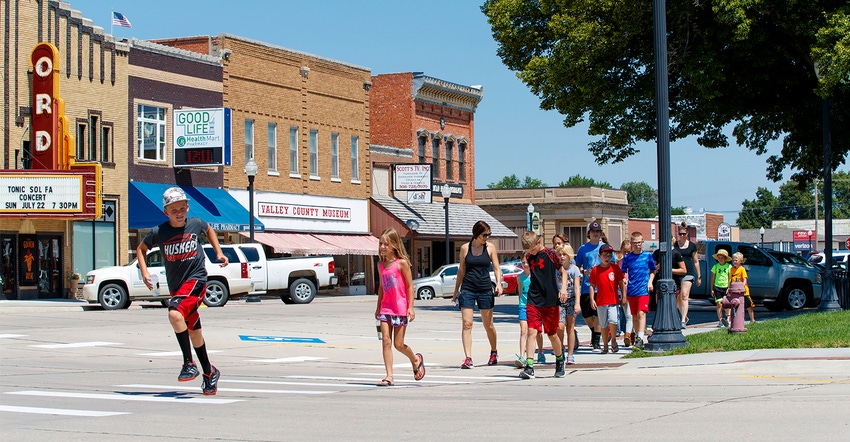April 10, 2020

This spring, the Nebraska Rural Poll will arrive in the mailboxes of 7,000 Nebraskans living in rural parts of the state, just as it has each year since 1996.
This year is special — 2020 marks the 25th anniversary of the poll, which has given rural Nebraskans an annual platform to voice their opinions and concerns on wide-ranging and important topics, including agricultural policy, energy, the environment, climate change, government, crime, education, health care, housing, immigration, taxes, community development strategies, technology and work.
"Rural people haven't always felt that they have much of a voice," said Becky Vogt, manager of survey research for the University of Nebraska-Lincoln's Department of Agricultural Economics, which developed and administers the poll. "Nebraska's urban population can sometimes overshadow the rest of the state."
The poll also gives city, state and federal leaders; economic development groups; researchers and others who use poll data a mechanism to measure changes over time in rural Nebraskans' sense of well-being and satisfaction with their communities, said Brad Lubben, a Nebraska Extension policy specialist.
The poll's founders, UNL agricultural economists John Allen and Sam Cordes, designed the poll so some questions about broad topics, including sense of personal well-being and satisfaction with services, were asked year after year.
"It's important to ask those questions every year to know which direction we are headed and where we are going," Lubben said.
Other questions are tailored to specific years. For example, recipients of this year's poll will be asked how closely they were connected to the 2019 flooding and bomb cyclone and whether they experienced damage as a result, Lubben said.
Last year's polls were mailed just as the flood hit, Lubben said, and responses started coming in shortly after. The flood still was in the national news, and volunteers from across the state, region and country were showing up to affected areas in droves to help clear debris, or with trailer loads of donated hay for livestock.
"The well-being reported last year was pretty strong," Lubben said. "Even people who experienced significant loss were thankful to have survived and were experiencing an outpouring of volunteerism. We'll find out if that same sense has held on over the year."
Rural Nebraskans are generally an optimistic bunch, according to poll data. Each year, the proportion of rural Nebraskans who say they are better off than they were five years ago has been greater than the proportion saying they are worse off. In 2019, 45% reported they were better off, and 19% reported they were worse off. During the past six years, the gap between the two groups has widened.
Rural residents also are increasingly positive about the future. The proportion saying they will be better off 10 years from now has been greater than the proportion saying they will be worse off throughout the history of the poll, Vogt said. Since 2013, the gap between the two groups has gradually widened.
At the same time, rural Nebraskans' satisfaction with services such as medical and nursing home care, mental health services, and access to senior centers generally has declined across all years of the study. In addition, satisfaction with entertainment, retail shopping and restaurants generally has declined over the past 20 years.
Each year, findings from the Rural Poll are distributed in a series of reports crafted by Vogt and a team of Lubben and other Nebraska faculty. This data is used widely by economic development groups; local, state and federal lawmakers; and nonprofits, among others. Findings from the poll are regularly lifted up in local and state media, but national outlets, including The New York Times and National Public Radio, also have cited the poll over the years.
Other states, including Mississippi, Texas, South Dakota and Ohio, have modeled survey efforts after the poll, Vogt said, and academic researchers have incorporated poll data into examinations of community satisfaction, migration intentions, residential preferences and other topics.
This year, 25 years into the poll's history, one year after historic flooding and in the midst of the COVID-19 pandemic, Vogt, Lubben and others will be watching closely to see how rural Nebraskans are faring.
Do students from rural areas have access to broadband and the ability to complete their studies remotely? How are tight-knit small communities doing during the era of social distancing? How is COVID-19 affecting rural economies?
The Rural Poll can help provide a sense of the impact of the unexpected on communities across Nebraska — and whether residents believe they can recover.
"We can never predict all of those unforeseen events," Lubben said, "but the poll does give us a way to measure how we are responding."
Pesek is communications director at UNL's Institute of Agriculture and Natural Resources.
Source: IANR News Service, which is solely responsible for the information provided and is wholly owned by the source. Informa Business Media and all its subsidiaries are not responsible for any of the content contained in this information asset.
You May Also Like




